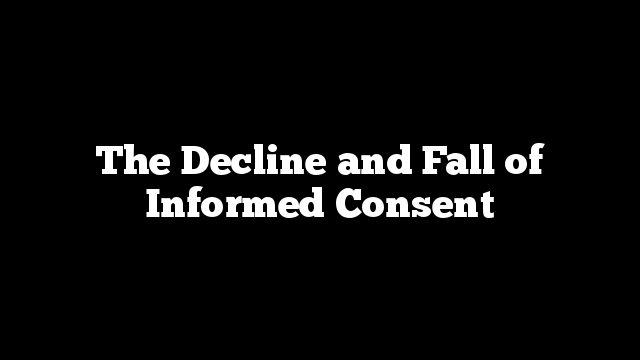
Margaret Edson’s 1999 Pulitzer Prize winning play, Wit, tells the story of the final hours of Vivian Bearing, PhD, an English professor dying of cancer. Early in the course of her disease, one of her doctors sees the value of her case from a research point of view and asks her to enroll in a clinical trial of an investigational therapy. In the film version of the play, which stars Emma Thompson, he hands her a two-page informed consent form to sign.
Wit deals with many timeless features of terminal illness, death, the care of the dying, and the meaning of life, but this aspect of it strikes many contemporary physicians and medical researchers as extraordinarily quaint. Informed consent remains an integral part of medicine, but the sight of an informed consent form that runs to only two pages – particularly one for an investigational cancer treatment protocol – seems nearly laughable.
Each year, millions of patients and research subjects are asked to sign informed consent forms. Situations where informed consent should be obtained include blood transfusions, surgical procedures, and participation in clinical research trials, among many others. The situation is familiar to many – the doctor walks in bearing a clipboard, explains the procedure, and asks the patient and a witness to sign on the bottom line. The only problem: it is often neither informed nor a real consent.
Consider a more contemporary, real-life case. A PhD from a science department at a major public university developed cancer. His physician presented him with the opportunity to enroll in a trial of a new agent under study for approval by the Food and Drug Administration. He took the 30-page document home with him that night. The next morning, he and his wife returned, both having reviewed it.
The expression on the professor’s face could best be described as exasperated. Here is what he said: “I tried reading this thing several times, but finally I just gave up. I am pretty smart, but I have enough to worry about with my diagnosis, and this informed consent form is so overwhelming that I simply can’t tell the difference between what is important and what is just legalese. Would you please just tell me about the study and so we can discuss it?”
Informed consent is a relatively new term, coined in the 1950s in the courts, when patients underwent ill-advised care and suffered adverse outcomes, not knowing that other options were available or that they could have simply declined. The idea is that patients should have the opportunity to learn about and decide whether to proceed with medical care or research that poses a risk that any reasonable person would want to know about.
The historical rationale for informed consent can be traced in part to the experiments performed by the Nazis during World War II. In many cases, physicians conducted risky, painful, and sometimes deadly experiments on thousands of concentration camp inmates without their consent. After the war, resulting military trials led to the Nuremberg Code, which established that medical experiments on human beings could be performed only with informed and voluntary consent.
No one would argue that research trials and medical care should be carried out without consent. However, the current practice of informed consent has evolved so far from what was originally intended that it might better be described as a mutation. In fact, it often resembles a monstrosity, no longer serving its primary purpose – to protect patients and research subjects – but instead now protects doctors, researchers, and institutions.
One problem is a faulty assumption that the more information is contained in the informed consent form, the more knowledgeable and therefore more protected the patient will be. Often every conceivable benefit, risk, and alternative is addressed, as well as financial issues such as who will pay for what, intellectual property rights, privacy protections, conflicts of interest, and language designed strictly to indemnify the institution.
Two fairly routine informed consent forms that we know run to 33 and 35 pages, respectively. The first includes a list of 108 side effects that may occur in those taking the drug, including “abnormal blood test results,” “pain,” and “murderous thoughts.” The second contains a chart of tests performed as part of the protocol, including 15 blood samples, 14 pregnancy tests, 9 thyroid function tests, and 4 symptom-directed physical exams. No wonder even a PhD can’t understand it.
To repeat, the length and complexity of the forms is being driven less by protecting the patient and more by protecting the institution, should something go wrong. Rightly or wrongly, people with oversight in such studies believe that if a problem is mentioned in advance, the probability of an unfavorable litigation outcome is reduced. As a result, informed consent forms are as unlikely to be read and understood as are the byzantine licensing agreements that accompany software updates.
One of the most important goals of informed consent is to protect patient autonomy, but the complexity of the forms makes patients more reliant than ever on doctors, researchers, and institutions to explain the risks and benefits. Just ask patients why they are being asked to sign the form. In our experience, many will offer the matter-of-fact reply: “Why, of course, to protect the institution.” In other words, patients may not understand the form, but they know that its purpose has been inverted.
The bodies that oversee informed consent, known as institutional review boards for the protection of human subjects (IRBs), continue to talk as though patient protection is the goal. We do not doubt their sincerity. But the complex process means that the vast majority of patients are operating strictly on trust, and the actual consent too often resembles a box-checking exercise. If we expect patients to actually read the form, we should present them with something at least a PhD can understand.
Richard Gunderman, MD is Chancellor’s is a professor of radiology at the University of Indiana. James Lynch, MS is a professor of oncology at the University of Florida.
